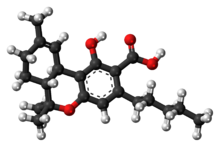Tetrahydrocannabinolic acid
 | |
 | |
| Clinical data | |
|---|---|
| Other names | 2-Carboxy-THC; THCA, 2-COOH-THC |
| ATC code |
|
| Identifiers | |
| |
JSmol) | |
| |
Tetrahydrocannabinolic acid (THCA, 2-COOH-THC;
THCA is found in variable quantities in fresh, undried cannabis, but is progressively
Uses
THCA is rarely directly used, but its presence is commonly analyzed when cannabis or hemp-based products are screened for THC; some countries require that it be measured in such screens.[2][3]: 32
THCA in its isolated form is available for purchase in select medical and recreational cannabis dispensaries in the form of a white crystalline powder. It can be smoked or vaporized in typical smoking devices, such as a bong or dab rig (device used for vaporizing hash oil). These methods convert the THCA to THC and so are used for their psychoactive effects. THCA is also sometimes encapsulated and taken as a supplement for a variety of illnesses, although there are currently no established medical applications.[4]
Pharmacological effects
Conversion of THCA to
A study found THCA and unheated
The
THCA binds to and activates
THCA shows a similar
Chemistry
It has two isomers, THCA-A, in which the carboxylic acid group is in the 1 position, between the hydroxy group and the carbon chain, and THCA-B, in which the carboxylic acid group is in the 3 position, following the carbon chain.[11]: 20 The crystal structures of both THCA-A (colourless prisms, orthorhombic P212121) and THCA-B (also colourless prisms, orthorhombic P212121) have been reported.[12][13]
In the past THCA was thought to be formed in plants by
It is unstable, and slowly decarboxylates into THC during storage, and the THC itself slowly degrades to CBN, which has potential immunosuppressive and anti-inflammatory activities.[1] When heated or burned, as when cannabis is smoked or included in baked goods, the decarboxylation is rapid but not complete; THCA is detectable in people who smoke or otherwise consume cannabis.[1]
Legal status
THCA is not scheduled by the United Nations' Convention on Psychotropic Substances.[14]
United States
THCA is not
See also
- Cannabinoids
- Cannabidiol (CBD)
References
- ^ PMID 28861488.
- PMID 15734104.
- ^ ISBN 978-92-1-148242-3. Archived from the original(PDF) on 29 August 2017.
- ^ Hanna A (2018-01-26). "What Is THCA Crystalline?". High Times. Retrieved 2020-02-04.
- ^ PMID 28861508.
- PMID 16504929.
- PMID 29082314.
- PMID 28853159.
- PMID 21985215.
- PMID 17219606.
- ISBN 978-1-59259-947-9.
- S2CID 231804940.
- PMID 1138526.
- ^ "Convention on Psychotropic Substances". 1971. Archived from the original on 2014-03-17. Retrieved 2015-09-21.
- ^ "§1308.11 Schedule I." Archived from the original on 2009-08-27. Retrieved 2014-12-29.
- ^ "Federal Controlled Substance Analogue Act Summary". Erowid Analog Law Vault.
- ^ "7 CFR § 990.25 - Standards of performance for detecting total delta-9 tetrahydrocannabinol (THC) concentration levels". LII / Legal Information Institute. Retrieved 2023-07-05.
- ^ "AGRICULTURE IMPROVEMENT ACT OF 2018" (PDF). Congress Public Law Library. Retrieved July 4, 2023.
